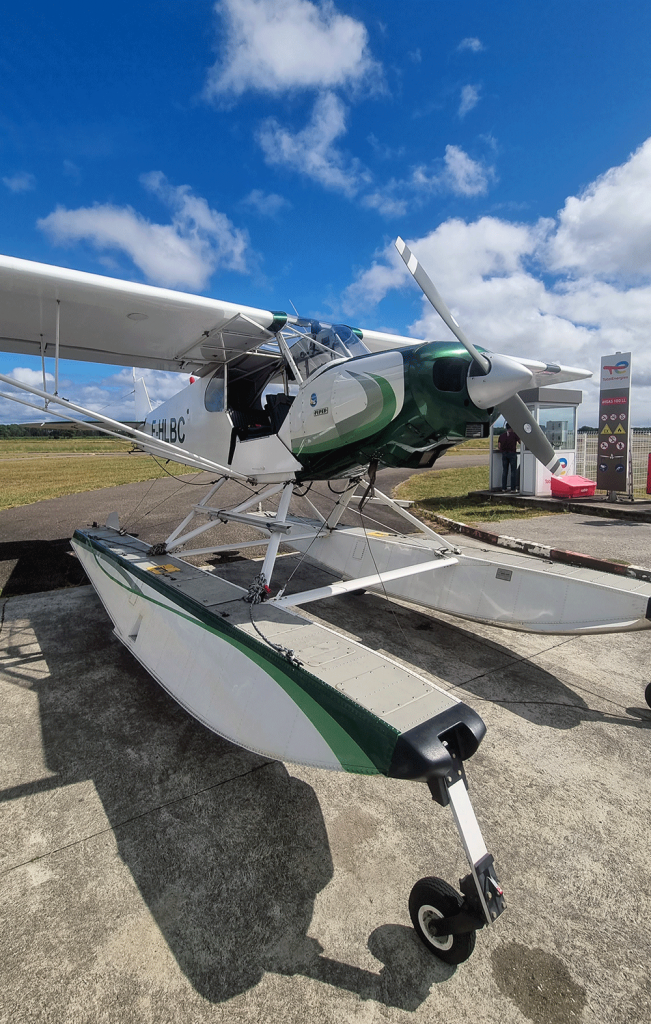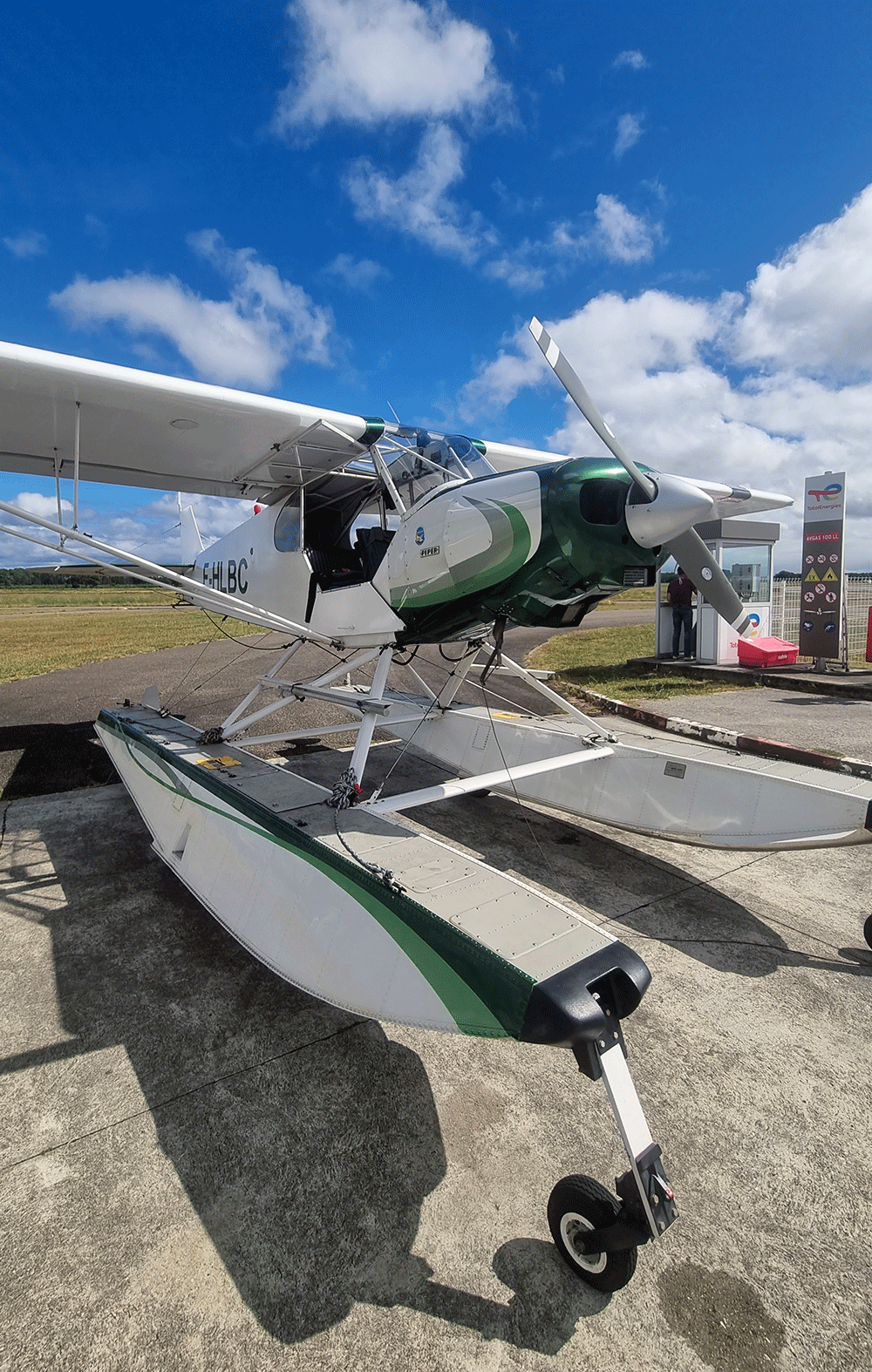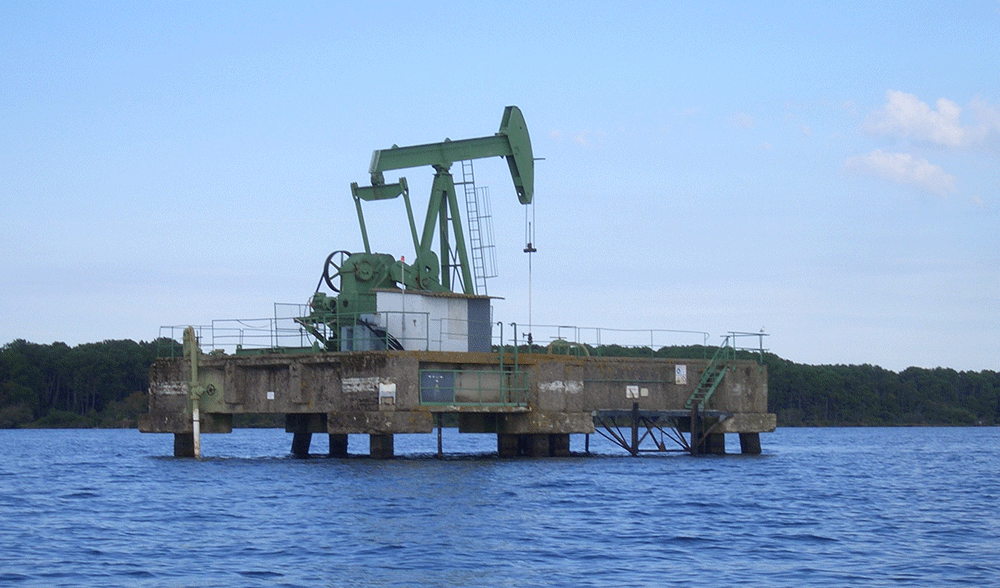Let’s be honest! You do not see a lot of seaplanes in Europe.
We do have lakes but not so many hydrobases around here. France has two (Biscarosse and Marignane) Italy has one on the lake of Côme, Scotland and Germany have one each as well.
Surprisingly we had one in Belgium for a very short while on the lake of l’eau d’heure (EBEH). Unfortunately it was short lived and closed in 2020 due to political refusal of the permit even after the aeronautical instances approuved the seaplanes activities on the lake. Nothing is simple and easy with aviation and Europe, we all know that already.
France leads the way with 2 hydrobases. One of them (Biscarosse LFHB) is famous due to the Latécoère assembly lines and test site of their seaplanes in the nineteen thirties. Latécoère used the lake to test fly its seaplanes and created the first hydrobase from which regular service would safely fly passengers across the Atlantic to New York, the French Antilles and South America.
Biscarosse is also the place where I usually go on holidays and since I started flying I have been eying the seaplanes playing on the south lake.
There are actually three lakes in the area:
The Northern lake called lac de Cazaux/Sanguinet, the smaller central lake is too small to do anything and the south lake named lac de Biscarosse/Parentis is where the Latécoère hydrobase is located.
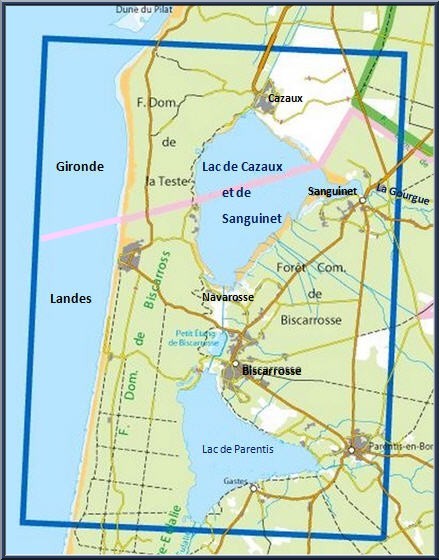
The Sanguinet lake is also a restricted military area due to the proximity of the French airforce Cazaux airbase hosting a flight testing site and training Singapore pilots (Belgian pilots were also trained there with our Alpha-jets for a while).
Part of the lake is restricted for navigation when the airforce base is open.
I spent most of my holidays on that lake doing wakeboard in the morning and sport catamarans in the afternoon when the wind picks up.
The Biscarosse lake is very different but has the same nautical activities with people in the water, divers, fast sailboats and fast motorboats. Surprisingly oil platforms scatters the lake. That is where the seaplane trains.
The Sanguinet lake is restricted from seaplane operations during the summer but the south end can be used once the holidays are over and navigation on the lake less intense.
It is important to note here the difference from an hydrobase to an hydrosurface.
An hydrosurface is a water surface where seaplanes can operate without facilities but these surfaces have to be approuved by the local authorities. As a seaplane pilot you cannot land anywhere – you must ensure you land on approuved hydrosurfaces.
In the area of Biscarosse some other lakes (Lacanau and Hourtin) can also be used as hydrosurfaces pending local authorities approuval, just like the south part of the Sanguinet lake outside of the holidays or lakes further South closer to the Pyrénées.
Last July (2023) I finally decided to pay a visit to the seaplane school at Biscarosse airport (LFBS) : Aquitaine hydravions
They currently have 3 seaplanes based at the airfield. Two PA-18 150HP and one Cessna 185 300 HP. These aircraft are amphibious thus retractable gear allowing them to take-off and land on the 09/27 LFBS runway and land on the nearby hydrobase or other hydrosurfaces.
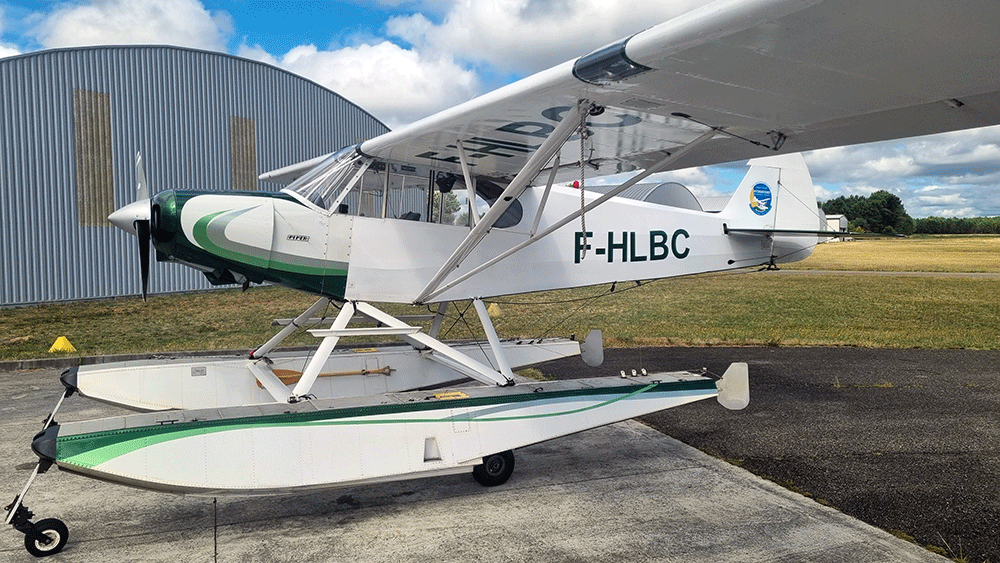
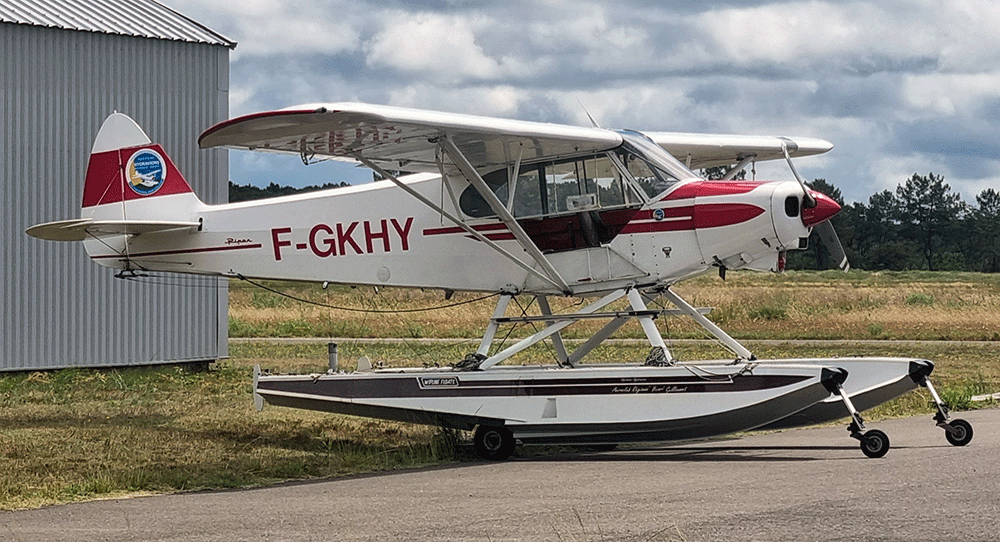
After a quick intro with the team, I organised an initiation flight on one of the two PA-18. I was assigned an instructor and F-HLBC.
The day of the flight started under heavy rain but the weather usually clears in the afternoon and my flight was scheduled at 3pm. From my experience with the Sanguinet lake I knew that the winds are usually calm in the morning (ideal for wakeboarding) and picks up in the afternoon (ideal for sailing). With winds comes waves and I was a little bit concerned that with the morning bad weather the waves on the lake might be too high for the seaplane to land on water. Wave limits for seaplane operations are 20 cm solo and 30 cm with an instructor so we’ll see when we get on the lake.
The flight started with a long briefing introducing seaplanes and area specificities.
It was very interesting although I did not come unprepared and studied this video (in french) the days before the flight:
After the briefing I was introduced to the cockpit of the PA-18.
The tandem configuration (and the retractable landing gear) will be other firsts for me and I must reckon I mostly fly low wings aircraft so I will have to pay extra attention to clear my turns, especially in the busy hydrobase airspace (from surface to 500 feet).
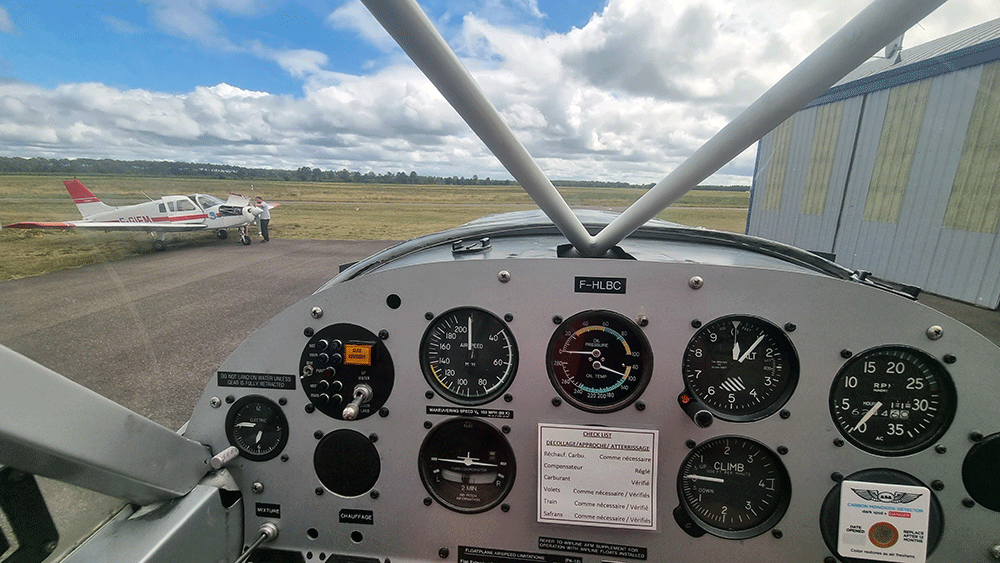
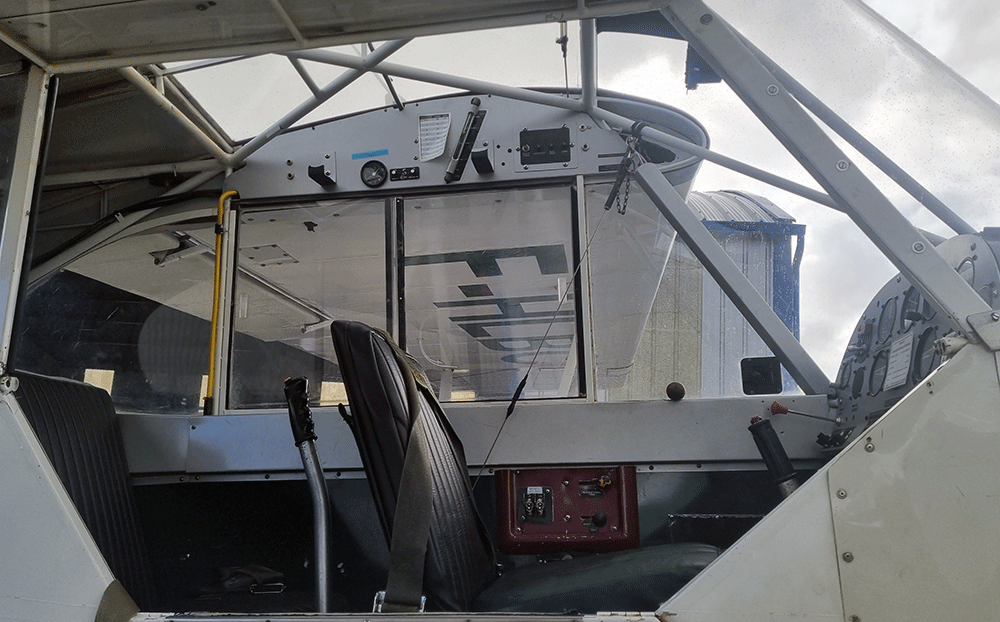
I noticed a few differences from what I am used to:
1. No gyro for heading so it is really going to be flying with visual reference points for making patterns (there’s a compass though)
2. The fuel gauges are tubes with a ball in them visible on the side above right against each wing. Much better than a needle you can’t trust.
3. A full instrument for the gear with 4 green lights for landing on the ground and 4 blue lights for water landing. It is critical to have the gear in the right position for water landing I will come back later to this.
4. The brakes are not on the top of the rudders like usually but they are separate pedals (heck, two pedal per foot) I had a lot of troubles with that in the beginning.
(look at the guys by the Piper Arrow in the picture above, they probably skipped a heartbeat when I slowly started rolling – sorry guys)
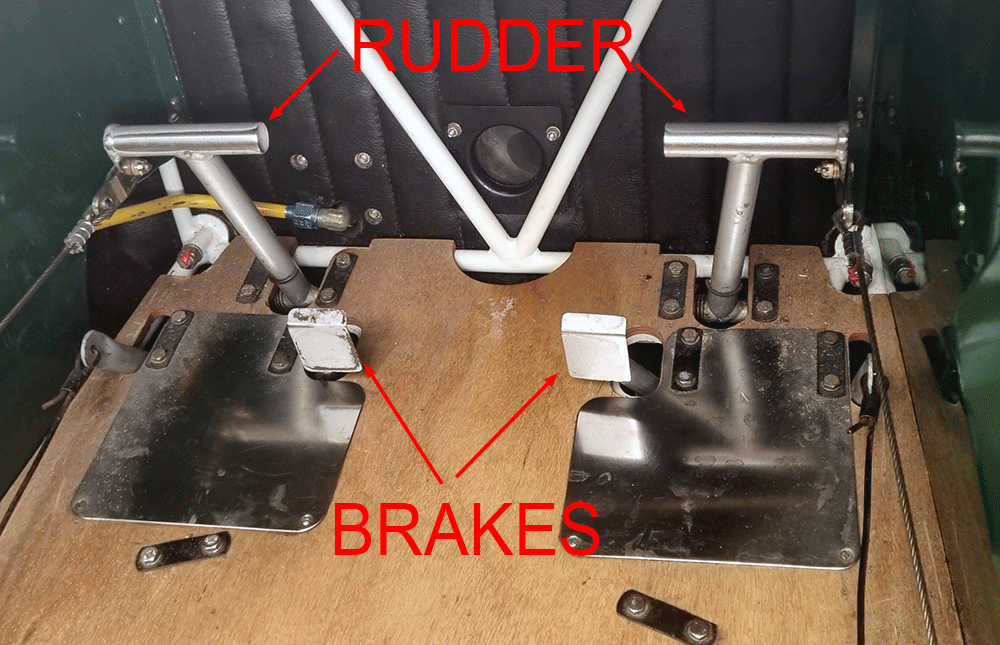
The cockpit familiarisation ended with the emergency exit procedure in case of flipped over water landing.
We then pre-flighted the aircraft in two steps. One usual for the airframe and one particular for the floats. After donning our life jackets we were ready for engine start.
Unfortunately I completely forgot to setup the gopro and things were happening so fast from that moment and I was so focused that I never thought of giving the controls to my instructor to snap a few pictures.
Winds were from the West so we took-off on RWY 27. I inquired about the procedure for taking off and landing with these huge floats hanging under us but it really is the same thing as with any aircraft. Safe for the added drag of course.
Biscarosse airfield pattern altitude is 900 feet MSL. The airspace above 1000 feet is owned by the military. Flying from Grimbergen, just under the Brussels international airport I am used to low flying, but seaplanes fly even lower, which is terrific.
The lake seaplane airspace is from surface to 500 feet under the LFBS pattern.
Speak of tight airspace !
Once at 250 feet with positive attitude we retracted the landing gear, checked the blue lights and checked the float gear indicator before turning towards the lake which is 2 minutes flying time away (I told you it happened fast)
We left the flaps out and kept the speed under 80 kts. Levelled at 400 feet and we were over the lake.
Once feet wet the mindset switches. There’s another mandatory check for the gear blue lights to ensure the aircraft is all setup for water operations, something we’ll check again before all water landing. If the gear is down when touching the water the aircraft will flip over on water contact. It happened before on the Biscarosse lake so everything possible is done to avoid it. The aircraft even has a visual and audio warning that the pilots has to acknowledge by pressing for the warning to disappear.
Over the lake at 400 feet, you realize it is such a busy area: aircraft above you in the airfield pattern, speedboat leaving white bow waves on the lakes, multiple oil platforms; sailboats at various speeds, swimmers, I didn’t see kites which was a good indication for the wind speed being not too strong but one really wonders how he is going to water land in all that!
First order of business, guess the wind. Well we took off on RWY 27 so we have a rather good idea of its general direction. That said we get multiple cues on the lake itself: the calm waters close to shores, the waves, the birds are all used to give us a water landing axis.
Next: find an aim point. Since there is no runway marked on the lake, you are told to invent your own runway on the lake. The wind has given you the direction, a visual landmark will give you the threshold. Luckily these oil platforms are just perfect. We decided to land abeam right of one these platforms.
So the runway is all set, except for traffic …

To check for traffic we get down to 200 feet and we overfly the sides of our imaginary runway looking for buoys, ships, swimmer, any kind of obstacle we don’t want to disturb or hit. On our first pass, two catamarans came from the south and were about to cross our runway, we also spotted a buoy right in the middle of our axis, so we switched our runway to the left of the oil platform (how cool is that? ). By the time we made our final pattern we hoped the sailboats would have crossed past our runway.
We climbed back to 400 feet and turned Crosswind. I turned the aircraft like I usually do but my visual cue for crosswind was passing too far, my instructor told me to turn steeper and turn that 90° quicker not to loose the landmark, which I loved. Sure enough I enjoyed all my next turns (with a bit more power than usual though).
Downwind we made all the checks and once the aimpoint platform was at 45° behind me I turned base, set my speed and started my descent. The runway was clear and indeed the sailboats were on my original chosen runway but clear of the new one. They would turn and sail back after we landed, so I kept them in my situational awareness for the next landing.
On final, it’s all about attitude and speed. You want to lock your attitude visually to ensure you touch down on the stronger part of the floats (the steps).
Needless to say that attitude/speed couple is critical is that’s where experience is needed.
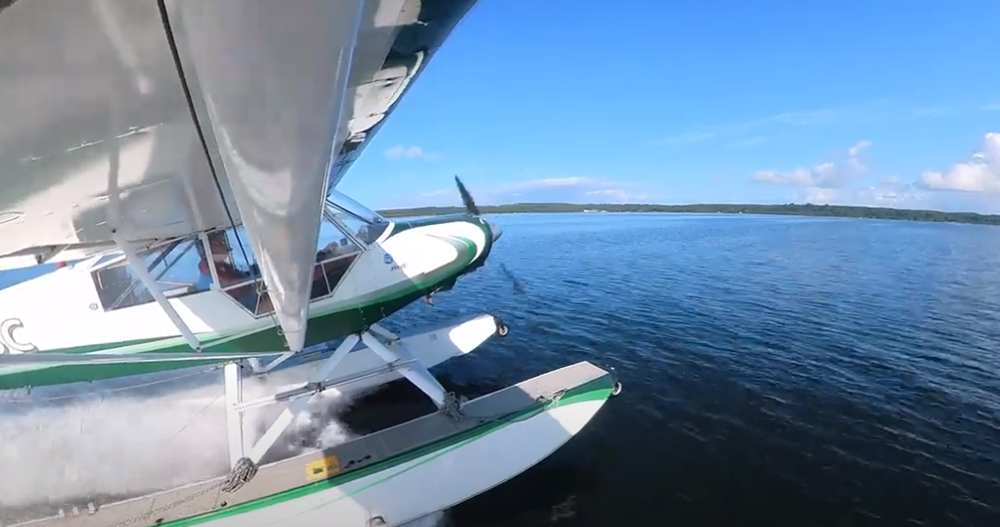
Once on the water the aircraft decelerates quite fast. You cannot call that a full stop but we turned to boat mode for just a small moment (you could then lower the retractable water rudders which are linked to the aircraft rudder and provide steerage on the water should you want to rejoin a quay or get up on the ramp of the Latécoère ramp). But we did not, we immediately setup for take off from the same imaginary runway after the usual checklists.
Taking off on the water is a completely different experience. You start by pulling the stick all the way back and give it full throttle. The aircraft nose will rise up and the bow wave will progress forward until it reaches the float steps. At that moment the aircraft nose pitches even further up, you give it three seconds and then you gently accompany the stick forward a bit to help the floats climb the wake and start surfing. The aircraft will then accelerate until the lift pulls the floats out of the water. You are an airplane again.
250 feet over the water, we turn for the next pattern. The waves on our first landing were just on the limit so we decided to make touch and goes or even low approach without touching the water. It is pretty usual to have strengthening waves as the wind picks up in the late afternoon.
After three more patterns over the lake (2 low approaches and 1 touch and go) we climbed back to pattern altitude behind a downwind traffic bound for LFBS. Passing feet-dry (I could not resist call it) our mindset switched back to airplane mode and we lowered the gear. Looking for 4 green lights on the instrument panel and checking visually the gear indicator on each float. Procedure is to check these visually every time you touch the landing gear switch.
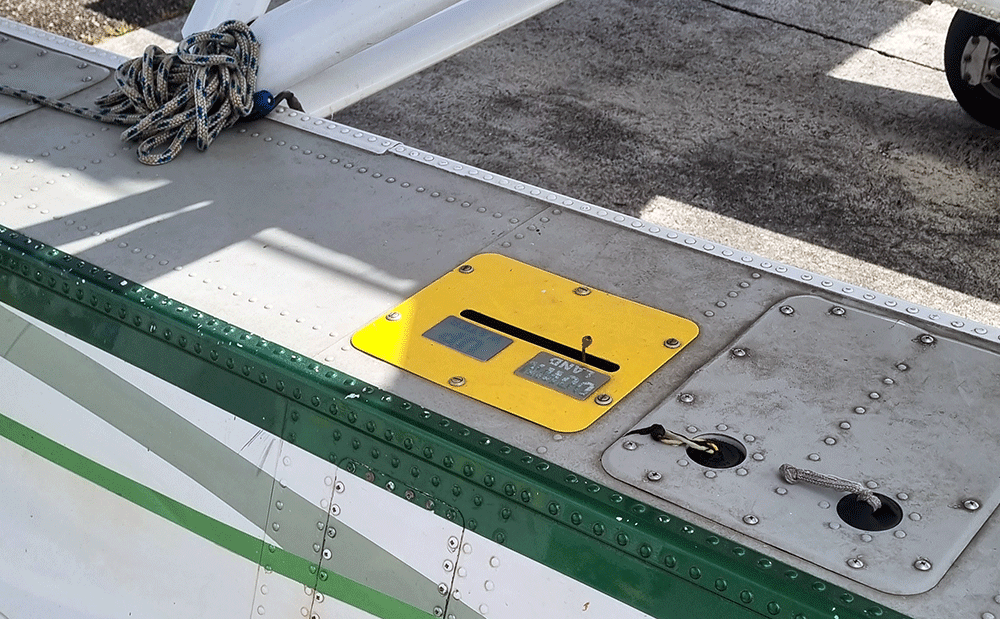
Just like for takeoff, I was concerned landing on the ground with these huge floats but the instructor reassured me and told me to do just as usual which I did and we touched smoothly but a bit long on RWY27. I learned that wet brakes don’t really brake well so we used the whole runway giving me more practice time with these weird brake pedals on the taxi back. A short stop at the refuelling station where we filled up half a wing tank each. Back at the parking we inspected the aircraft and emptied water from the floats (just like we do after a catamaran sortie on the lake)
So should I want to get the seaplane rating?
Well it is definitely intense and has the potential to teach pilots a lot of things.
You really need to be precise and sharp in your piloting. That’s a great and beneficial learning experience. Managing water traffic is highly dynamic and you must act quickly and remain safe for all in all situations.
Finally I drive boats and I pilot airplanes. Why not mixing the two and get the seaplane rating? it’s too great a temptation to pass!
Sure it won’t serve a huge purpose on the old continent but at least I can fly to distant lakes when I’m on holidays in South West France. The idea to beach a sailplane with my wife and have lunch on the beach is really appealing 🙂 It is already a great experience with a boat, I’m sure it’s even greater with a plane !!
The rating requests 8 hours dual training and 1hour with a flight examiner. After which you can fly a seaplane solo if you have 200 hours total flight time.
The rating also includes retractable landing gear which is useful.
So yes, September 2024 is the moment I’ll take that course.
Many thanks to Aquitaine Hydravions for the nice afternoon spent with them and to Didier who initiated me to seaplane flying. I’ll see you guys back soon.
